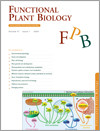
Functional Plant Biology
Volume 47 Number 1 2020
Although the roles of nitric oxide (NO) in plant abiotic stress response have been well documented, not much is known about the function of NO-based protein S-nitrosylation under unfavourable environments. This review demonstrates the roles of S-nitrosylation and highlights the importance of this protein modification under abiotic stress in plants. S-nitrosylation seems to regulate plant abiotic stress response by modifying proteins in respiratory and photorespiratory pathways and in some antioxidant enzymes.
As freshwater resources become more limited, precision irrigation management of economically important crops such as wine grapes becomes increasingly important. The wide diversity in wine grape cultivars grown throughout the world suggests that there is a broad range in responses to drought, but the present showed that this range is most pronounced under moderate drought conditions, and is less obvious at very wet or very dry conditions. Optimising irrigation management protocols should consider cultivar-specific responses to drought.
FP19073 Abstract | FP19073 Full Text | FP19073PDF (536 KB) Open Access Article
Wheat leaf rust is an important disease of wheat that invariably impacts wheat production, so leaf rust resistance genes identified in breeding programs help in the development of novel wheat cultivars with enhanced resistance. In this study we assessed the function of a β-1,3-glucanase gene in adult resistance to leaf rust. Our findings will help us gain insight into better understanding the mechanism of β-1,3-glucanase gene involved in wheat defence against the leaf rust pathogen and provide shortcut for wheat breeding.
To maximise the utilisation of solar energy by switchgrass, precise variations underlying the structural and physiological differences during different growth stages between two ecotypes of switchgrass were measured. Our data demonstrate that solar energy utilisation of switchgrass from each ecotype was maximised by structural or physiological strategies with enhanced cell proliferation or more photosynthetic pigments. Our results provide a clear ability to scale up the production from structural and physiological modification to crop production.
FP19072Physiological response in the leaf and stolon of white clover under acid precipitation and freeze–thaw stress
 , Wenyi Tang, Fanglin He, Weiwei Chen, Yue Zhu, Cunxin Fan, Mengyu Zhang, Yixin Chang, Jiaxing Sun and Xuemei Ding
, Wenyi Tang, Fanglin He, Weiwei Chen, Yue Zhu, Cunxin Fan, Mengyu Zhang, Yixin Chang, Jiaxing Sun and Xuemei Ding
Freeze–thaw and acid rain are common stresses affecting white clover in northern China. The simulation experience indicates that the stolon of white clover is more sensitive than leaves to short-term stress, either as single freeze–thaw stress or the combined stress of freeze–thaw and acid rain. The important temperature points for the antioxidant protection system are 5°C and –5°C, and maintaining more leaves may contribute to stress resistance.
FP19150Lipid remodelling plays an important role in wheat (Triticum aestivum) hypoxia stress
Cell membrane lipid remodelling is one of the strategies that plants have developed to combat abiotic stress because of its structural and signalling role. Different membrane lipid adjustments in wheat under oxygen deficiency could be partly responsible for the differing tolerance of Seri M82 (sensitive) and CIGM90.863 (tolerant). This study will help us to understand how wheat tolerates hypoxia stress through lipid remodelling and provide theoretical guidance for crop breeding.
Euphorbia kansui is well-known in traditional Chinese medicine and its pharmacological effects are related to terpenoids, which are mainly stored in laticifers. Our results suggest that partial cytoplasmic degradation correlates with latex particle production or secondary metabolite synthesis during laticifer development. Furthermore, UV-B radiation can increase plants’ resistance by promoting laticifer development. The information provides a basis for further explorations of laticifer development, and terpenoid synthesis and regulation in E. kansui.
A new morphological method was constructed to define the level of chilling injury by leaf angle and leaf state of melon seedlings. The validity of the method was verified by seedling growth and related physiological characteristics. The new method will be of great significance for screening and breeding cold-tolerant melon cultivars.




